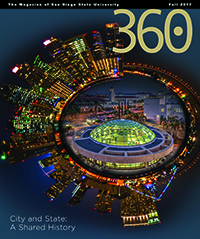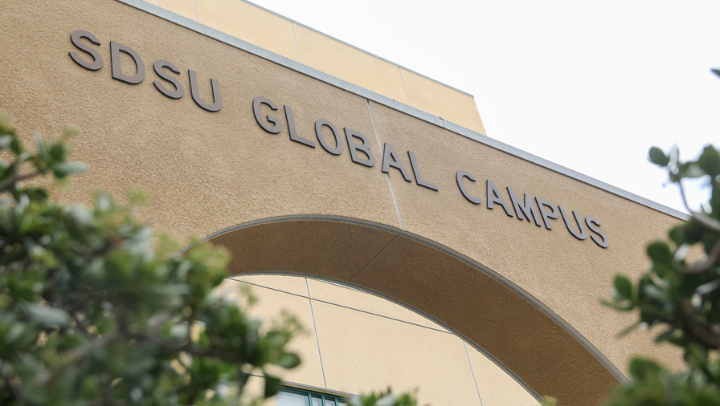Hacking into History
Special Collections and University Archives is a wellspring of living history for students, researchers and the San Diego community.

This story appears in the fall 2017 issue of 360: The Magazine of San Diego State University.
As early as 1897, when San Diego State University was established as San Diego Normal School to train and certify teachers, President Samuel Black recognized the importance of recording and preserving the institution’s history.
A man of great perception, he also understood the Normal School’s role as caretaker of historically significant items that San Diegans and others might bequeath over the years. But neither he nor his staff of 10 could have predicted the eventual size, diversity and value of the collection.
The SDSU Library’s Special Collections and University Archives is a repository for more than 80,000 printed volumes, over 500 manuscript and archival collections, 800 linear feet of university records, plus numerous graphic and digital collections and ephemera.
While most modern universities have archives and historical collections, the breadth of SDSU’s is exceptionally wide and deep to support a dynamic graduate and undergraduate curriculum, said director Robert Ray.
Old and modern

It’s a decidedly eclectic treasure trove. Among the oldest pieces are 13 incunabula, printed volumes published before 1501. Equally rare is Samuel Johnson’s 1755 Dictionary of the English Language and a first edition of “De revolutionibus orbium coelestium,” the 1543 text in which astronomer Nicolaus Copernicus advanced the revolutionary concept of a heliocentric planetary system.
Closer to home and more contemporary, the Harold K. Brown Civil Rights and African American Experience Collection documents the history of San Diego’s black community in photographs, newspaper clippings and correspondence gifted by the 1959 alumnus and former SDSU administrator.
Unidos Por la Causa: The Chicana and Chicano Experience in San Diego was assembled through gifts from alumni and friends to be a traveling display of photos, art and documents illustrating the 1960s and ‘70s Chicano movement in San Diego. The centerpiece is a treasury of 62 colorful posters and broadsides promoting anti-war marches, student conferences and other cultural and political events.
Special Collections also safeguards photographs and stage notes from the Old Globe, San Diego’s first professional theatre, and a collection of nearly 3,000 postcards bequeathed by former humanities chair John Adams (1900-1994) and his wife, Jane. Among the oldest of these pictures Balboa Park in 1915, newly constructed for the Panama-California Exhibition; others show the El Cortez Hotel, renowned as San Diego’s tallest building in 1927; and the “new” San Diego State College campus on Mission Palisades, as it was known in 1931, shortly after Adams joined the faculty.
Pieces of Americana
Not all of the treasures have a local flavor. There is a comic arts collection of 50,000 individual comic “floppies” and nearly 200 graphic novels; an array of photographs, text and art devoted to surfing; a collection documenting the history of printing and typography and the art of the book; and a digital collection of popular sheet music from the early 20th century.
Among the most recent donations are the Codling Newspaper Collection from George (’67) and Dorothy (’66) Codling; the Torah Scrolls Collection from Howard and Jill Singer, whose daughter, Jaclyn, graduated in 2012; and the Edward E. Marsh Golden Age of Science Fiction Collection, valued at more than $2 million.
The Codling collection includes East Coast newspapers published from 1792 to 1800, featuring articles about the death of George Washington, the trial and execution of Louis XVI of France and interviews with America’s second president, John Adams.
The Singers’ gift comprises more than 70 Torah scrolls or fragments—some nearly 800 years old—from Turkey, Morocco, Spain and the Netherlands. Ancient maps of these countries are part of the collection.
Unique and universal
Marsh gifted his collection to SDSU in 2013. It includes signed and inscribed first editions by science fiction greats Arthur C. Clarke, Ray Bradbury, Isaac Asimov, Jules Verne and H.G. Wells, and an extensive collection of the authors who influenced L. Ron Hubbard, founder of the Church of Scientology.
“This collection is an incredible jewel, not just to science fiction fans, but also to students and researchers in the fields of science, technology, politics, religion, philosophy, journalism, even theatre and film,” said Gale Etschmaier, library dean.
Donald Westbrook, who received a Ph.D. in religious studies from Claremont Graduate University in 2015, called the collection “a preeminent resource for scientology studies [which] continues to receive fuller academic attention as one of many American-born new religious movements.” His book about the Church of Scientology is due out next year from Oxford University Press.
In late September, the Edward Marsh Golden Age of Science Fiction Room officially opened on the first floor of the SDSU Library. The glass-fronted space will not only house the Marsh collection, it will also become a point of contact between Special Collections staff andthe community.
Living history
Etschmaier said relocating Special Collections to the library space in and around the Marsh Room will strengthen SDSU’s role as a source of “living history”—the documents, photos, letters, newspaper clippings and oral accounts that enable researchers to understand the past through their own critical senses rather than through another’s interpretation.
Newly-minted Ph.D. Mychal Odom, who studied at the University of California, San Diego, used SDSU’s Special Collection extensively to research his dissertation on the influences of African liberation movements on civil rights, economic justice and anti-apartheid activism in 1960s Southern California.
He said the Harold Brown collection includes one-of-a-kind papers, correspondence and newspaper clippings plus oral histories from San Diego’s African American icons, including the Hon. Leon Williams, Rev. George Walker Smith and Brown himself.
“Hal Brown’s oral history alerted me to the existence of the Afro-American Association, an important activist group that worked in San Diego alongside the Congress of Racial Equality (CORE),” said Odom. “Also hearing about his time in Lesotho for the Peace Corps allowed me to make connections between Africa and San Diego in a way that had not been done before.“
Similarly, the comic arts and graphic novels collections contain materials that exist nowhere else, and support SDSU’s commitment to diversity, Etschmaier said.
“These collections are grounded in themes that more traditional genres do not always explore, such as race, gender, social justice and dystopia,” she said.
Clearly, Special Collections and University Archives is more than a repository for treasures from humanity’s past.
It is also a rich source of knowledge for scholars researching the most contemporary issues and a valuable resource for the San Diego community.
The Marsh Room will be open to the public in the 2018 spring semester, Monday-Friday, 10 a.m.-4 p.m.
Watch the video: sdsu.edu/historical



